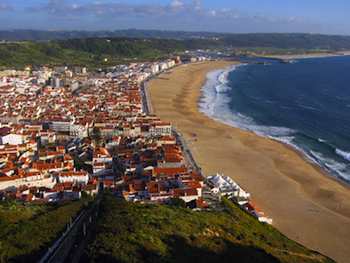- MENU
- HOME
- SEARCH
- WORLD
- MAIN
- AFRICA
- ASIA
- BALKANS
- EUROPE
- LATIN AMERICA
- MIDDLE EAST
- United Kingdom
- United States
- Argentina
- Australia
- Austria
- Benelux
- Brazil
- Canada
- China
- France
- Germany
- Greece
- Hungary
- India
- Indonesia
- Ireland
- Israel
- Italy
- Japan
- Korea
- Mexico
- New Zealand
- Pakistan
- Philippines
- Poland
- Russia
- South Africa
- Spain
- Taiwan
- Turkey
- USA
- BUSINESS
- WEALTH
- STOCKS
- TECH
- HEALTH
- LIFESTYLE
- ENTERTAINMENT
- SPORTS
- RSS
- iHaveNet.com: Travel
By Ed Perkins

Grand View of Nazare and its Golden Beach
Photo: Robert Wright
Nazare, a two-hour drive north of Lisbon on Portugal's Atlantic coast, is famous for its women who wear skirts with seven petticoats (one for each day, for the seven colors of the rainbow, or ... make up your own legend). While this tradition helps stoke the town's tourist trade, it's also just the way people live here.
In the old days, women would sit on the beach waiting for their fishermen to sail home. To keep warm in the face of a cold sea wind while staying modestly covered, they'd wear several petticoats in order to fold layers around their backs and legs. Even today, older and more traditional women wear short skirts made bulky by several -- but not seven -- petticoats. The ensemble is completed with house slippers, an apron (embroidered by the wearer), a small woolen cape, headscarf, and flamboyant jewelry, including chunky gold earrings (often passed down from generation to generation). It actually gives the town an exotic, time-passed feel. You'll see a few women wearing black, a sign of mourning. Traditionally, if your spouse died, you wore black for the rest of your life. While this tradition is still observed, mourning just ain't what it used to be -- in the last generation, widows began remarrying.
I got hooked on Nazare back when colorful fishing boats littered its long, sandy beach. Now, rather than crashing through the surf to reach the beach in the town center, the boats motor comfortably into a new harbor, a 30-minute walk south of town. Today, the beach is littered with frolicking families, and it seems that most of Nazare's 10,000 inhabitants are in the tourist trade. But I still like the place.
The energetic applause of the surf, widows with rooms to rent, and big plates of steamed shrimp will greet you. You can relax in this sunny land of cork groves, eucalyptus trees, and men who stow cigarettes and fishhooks in their stocking caps.
Even with its summer crowds, Nazare is a fun stop that offers a surprisingly good look at old Portugal. Wander the back streets for a fine look at family-in-the-street life. Laundry flaps in the wind, kids play soccer, and fish sizzle over tiny curbside hibachis. Squadrons of sun-dried and salted fish are crucified on nets pulled tightly around wooden frames and left under the midday sun. (Locals claim they are delightful, but I don't know.) Off-season Nazare is almost empty of tourists -- inexpensive, colorful, and relaxed, with enough salty fishing-village atmosphere to make you pucker.
The beach is the domain of the summertime beach tents, a tradition in Portugal. In Nazare, the tents are run as a cooperative by the old women you'll see sitting in the shade ready to collect 6 euros or more a day. The beach is groomed and guarded, and in the evening, piped music is played. Flags indicate danger level: red (no one allowed in the water), yellow (wading is safe), and green (no problem).
If you stroll along the promenade toward the new harbor, you'll come to three traditional boats in the sand, with prows high to cut through the surf. Try to imagine the beach (before 1986) littered with boats like these, with old men mending their nets. Oxen (and later, tractors) would haul the boats out each day.
Near the boats there remains a mackerel crucifixion zone -- where ladies still dry their mackerel and sardines in the sun. Preparing and selling fish is the lot of Nazare women married to fishermen. Stroll to people-watch. Traditions survive even among younger girls.
Nazare faces its long beach, stretching north from the new harbor to Sitio, the hill-capping old part of town. Riding the Eiffel-era funicular up the cliff to Sitio, you come upon what feels like a totally separate village. Its people don't fish; they farm.
From the edge of the bluff you can survey Nazare and its golden beach stretching all the way to the new harbor. The stone memorial on the belvedere ("beautiful view") honors Vasco da Gama, who stopped here before leaving Europe for India. The tiny chapel next to the monument sits on the spot where the statue of the Black Madonna hid in the rocks for 400 years, waiting for the Moors to go away and for the Christians to remember her.
The bandstand marking the center of the square is a reminder that this is the heart of the town's busy festival schedule. In the summer, smoke rises from the many outdoor grills, and the inviting smell of cooking fresh fish entices you to sit down for a plate of sardines.
Nazare doesn't have any blockbuster sights. It's simply a fine way to enjoy the endearing charms of Portugal.
© Rick Steves
AUTOS | HOBBIES | EDUCATION | FAMILY | FASHION | FOOD & RECIPES | HOME DECOR | RELATIONSHIPS | PARENTING | PETS | TRAVEL | WOMEN
Travel | Portugal's Nazare: Beach Town with Traditions | Rick Steves' European Travels